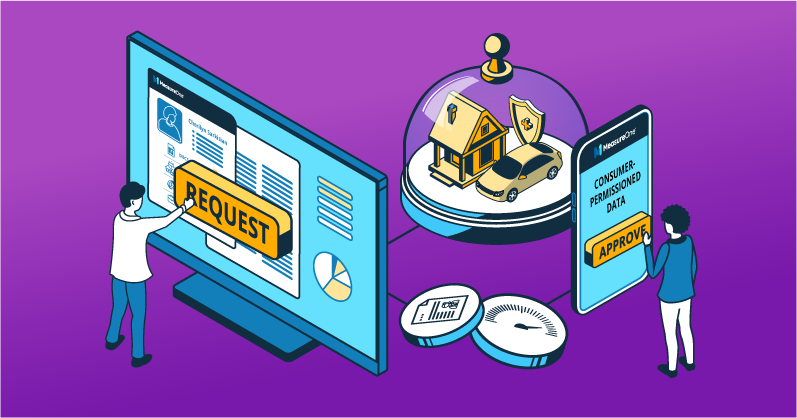Embedded insurance is a rapidly growing tech trend taking the insurance industry by storm. To put it simply, embedded insurance is a way for companies to offer insurance products and offerings to their customers within their existing purchase flow. For instance, when you purchase an airline ticket and get offered trip protection—that’s embedded insurance.
While this form of selling insurance and insurance bundling is not a new concept, advances in technology have made embedded insurance more accessible than ever before. Auto and mortgage lenders, for example, can leverage embedded insurance to attract insurance partners or diversify their loan offerings to include insurance, create a seamless borrower experience, and expand their market share.
Embedded insurance in the past, present, and future
Embedded insurance is a long-standing practice in the insurance industry, allowing companies to bring the convenience of purchasing insurance to their customers. Popularized by Allstate in the 1920s, it has continued to be instrumental in helping businesses reach more customers and provide a better customer experience by adding convenience and marketability. While the way it was used in decades past may not have been a tech-first approach, the use of embedded insurance today has only evolved using technology to become more accessible for consumer-focused businesses.
Today, according to Coverager, companies in retail, banking, fintech, airline, lending, and more want to embed digital insurance add-ons to their own product and service offerings. Companies like Paypal, Intuit, and Chime have partnered with insurance companies to do just that. With embedded insurance, companies can help their customers access and buy insurance coverage that suits their needs. For home and auto lenders, this opportunity opens the door for more customers to seamlessly add comprehensive insurance coverage, leverage bundled discounts, and more, as part of their loan process, helping to speed up underwriting and convert more borrowers.
Why lenders should lean on embedded insurance
So what can embedded insurance do for home and auto lenders? For an auto loan or mortgage loan to close, the borrower must secure the appropriate insurance (auto or homeowners). As a required component of underwriting and loan closing, lenders can leverage embedded insurance to sell coverage directly within their own platforms or websites, creating a comprehensive and seamless borrower experience. The benefits of using embedded insurance are significant.
By using embedded insurance, lenders can expect to:
- Produce more income: When a lender provides an additional service, they open up their own marketplace beyond a home or auto loan. Offering insurance, which is required for home and auto loans, as an add-on product embedded in the current buyer flow is an easy way to drive additional income.
- Increase conversions: Having the option to purchase an auto or homeowners insurance policy through a mortgage or auto lender reduces customer friction during the lending process and helps consumers finalize the steps required for a loan to close in one place.
- Improve the customer experience: Immediate access to insurance offerings gives customers a direct line to purchase necessary auto or homeowners insurance, leading to a more positive, streamlined experience. It’s safe to say that better customer experiences lead to customer retention, referrals, and ultimately increased revenue
All these factors make embedded insurance an attractive option for lenders who want to stay ahead of the competition in today's rapidly changing digital landscape.
How home and auto lenders can easily take advantage of embedded insurance with CPD
Consumer-permissioned data (CPD) is the ability for consumers to share their data directly from their online accounts. With the right CPD platform, this instant delivery of data such as insurance policy or declarations page eliminates outdated processes like paper documentation, back-and-forth phone calls, faxes, and more.
Using consumer-permissioned data is a simple, cost-efficient way to fast-track embedded insurance by enabling lenders to quickly access a borrower’s current policy so that they may push a comparative and competitive insurance product.. The digitization that CPD supports is a significant part of enabling insurance add-ons, comparisons, and more. For auto and home lenders who want to benefit from distributing insurance to their customers via embedded insurance, the clear next step is finding a platform that can work with their native processes to collect the necessary consumer data.
MeasureOne’s consumer-permissioned data platform does just that, presenting instant data collection in limited steps from within any digital channel: on a website, in a digital application, and via email or text.
When you partner with MeasureOne, auto and home lenders also gain:
- Automation leading to faster lending decisions: Immediate, up-to-date secure borrower data using an integrated borrower workflow including insurance and VOIE. and reduced manual load and human error during the income and insurance verification process
- Marketing-leading coverage/conversion: 5000+ payroll processors,100% coverage of US employees supporting of every type of worker, and 95% coverage of insurance carriers
- Lowest costs in the space: MeasureOne’s platform gathers data by API rather than manpower to verify documentation and connect to third parties and comes at a lower cost than leading competitors.
- Better technology and scalability: Technical ability to deliver a one-stop-shop for consumer data for your current and future needs
MeasureOne brings secure, transparent data to the table for the benefit of lenders and their consumers.

